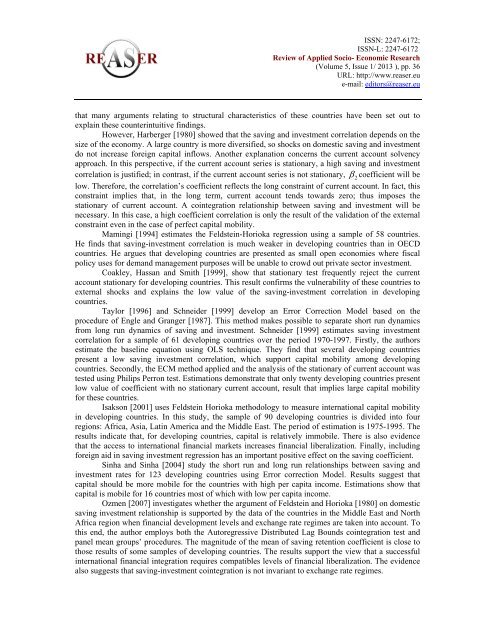new characteristics of inequalities in the information society and ...
new characteristics of inequalities in the information society and ...
new characteristics of inequalities in the information society and ...
You also want an ePaper? Increase the reach of your titles
YUMPU automatically turns print PDFs into web optimized ePapers that Google loves.
ISSN: 2247-6172;<br />
ISSN-L: 2247-6172<br />
Review <strong>of</strong> Applied Socio- Economic Research<br />
(Volume 5, Issue 1/ 2013 ), pp. 36<br />
URL: http://www.reaser.eu<br />
e-mail: editors@reaser.eu<br />
that many arguments relat<strong>in</strong>g to structural <strong>characteristics</strong> <strong>of</strong> <strong>the</strong>se countries have been set out to<br />
expla<strong>in</strong> <strong>the</strong>se counter<strong>in</strong>tuitive f<strong>in</strong>d<strong>in</strong>gs.<br />
However, Harberger [1980] showed that <strong>the</strong> sav<strong>in</strong>g <strong>and</strong> <strong>in</strong>vestment correlation depends on <strong>the</strong><br />
size <strong>of</strong> <strong>the</strong> economy. A large country is more diversified, so shocks on domestic sav<strong>in</strong>g <strong>and</strong> <strong>in</strong>vestment<br />
do not <strong>in</strong>crease foreign capital <strong>in</strong>flows. Ano<strong>the</strong>r explanation concerns <strong>the</strong> current account solvency<br />
approach. In this perspective, if <strong>the</strong> current account series is stationary, a high sav<strong>in</strong>g <strong>and</strong> <strong>in</strong>vestment<br />
correlation is justified; <strong>in</strong> contrast, if <strong>the</strong> current account series is not stationary, <br />
2<br />
coefficient will be<br />
low. Therefore, <strong>the</strong> correlation’s coefficient reflects <strong>the</strong> long constra<strong>in</strong>t <strong>of</strong> current account. In fact, this<br />
constra<strong>in</strong>t implies that, <strong>in</strong> <strong>the</strong> long term, current account tends towards zero; thus imposes <strong>the</strong><br />
stationary <strong>of</strong> current account. A co<strong>in</strong>tegration relationship between sav<strong>in</strong>g <strong>and</strong> <strong>in</strong>vestment will be<br />
necessary. In this case, a high coefficient correlation is only <strong>the</strong> result <strong>of</strong> <strong>the</strong> validation <strong>of</strong> <strong>the</strong> external<br />
constra<strong>in</strong>t even <strong>in</strong> <strong>the</strong> case <strong>of</strong> perfect capital mobility.<br />
Mam<strong>in</strong>gi [1994] estimates <strong>the</strong> Feldste<strong>in</strong>-Horioka regression us<strong>in</strong>g a sample <strong>of</strong> 58 countries.<br />
He f<strong>in</strong>ds that sav<strong>in</strong>g-<strong>in</strong>vestment correlation is much weaker <strong>in</strong> develop<strong>in</strong>g countries than <strong>in</strong> OECD<br />
countries. He argues that develop<strong>in</strong>g countries are presented as small open economies where fiscal<br />
policy uses for dem<strong>and</strong> management purposes will be unable to crowd out private sector <strong>in</strong>vestment.<br />
Coakley, Hassan <strong>and</strong> Smith [1999], show that stationary test frequently reject <strong>the</strong> current<br />
account stationary for develop<strong>in</strong>g countries. This result confirms <strong>the</strong> vulnerability <strong>of</strong> <strong>the</strong>se countries to<br />
external shocks <strong>and</strong> expla<strong>in</strong>s <strong>the</strong> low value <strong>of</strong> <strong>the</strong> sav<strong>in</strong>g-<strong>in</strong>vestment correlation <strong>in</strong> develop<strong>in</strong>g<br />
countries.<br />
Taylor [1996] <strong>and</strong> Schneider [1999] develop an Error Correction Model based on <strong>the</strong><br />
procedure <strong>of</strong> Engle <strong>and</strong> Granger [1987]. This method makes possible to separate short run dynamics<br />
from long run dynamics <strong>of</strong> sav<strong>in</strong>g <strong>and</strong> <strong>in</strong>vestment. Schneider [1999] estimates sav<strong>in</strong>g <strong>in</strong>vestment<br />
correlation for a sample <strong>of</strong> 61 develop<strong>in</strong>g countries over <strong>the</strong> period 1970-1997. Firstly, <strong>the</strong> authors<br />
estimate <strong>the</strong> basel<strong>in</strong>e equation us<strong>in</strong>g OLS technique. They f<strong>in</strong>d that several develop<strong>in</strong>g countries<br />
present a low sav<strong>in</strong>g <strong>in</strong>vestment correlation, which support capital mobility among develop<strong>in</strong>g<br />
countries. Secondly, <strong>the</strong> ECM method applied <strong>and</strong> <strong>the</strong> analysis <strong>of</strong> <strong>the</strong> stationary <strong>of</strong> current account was<br />
tested us<strong>in</strong>g Philips Perron test. Estimations demonstrate that only twenty develop<strong>in</strong>g countries present<br />
low value <strong>of</strong> coefficient with no stationary current account, result that implies large capital mobility<br />
for <strong>the</strong>se countries.<br />
Isakson [2001] uses Feldste<strong>in</strong> Horioka methodology to measure <strong>in</strong>ternational capital mobility<br />
<strong>in</strong> develop<strong>in</strong>g countries. In this study, <strong>the</strong> sample <strong>of</strong> 90 develop<strong>in</strong>g countries is divided <strong>in</strong>to four<br />
regions: Africa, Asia, Lat<strong>in</strong> America <strong>and</strong> <strong>the</strong> Middle East. The period <strong>of</strong> estimation is 1975-1995. The<br />
results <strong>in</strong>dicate that, for develop<strong>in</strong>g countries, capital is relatively immobile. There is also evidence<br />
that <strong>the</strong> access to <strong>in</strong>ternational f<strong>in</strong>ancial markets <strong>in</strong>creases f<strong>in</strong>ancial liberalization. F<strong>in</strong>ally, <strong>in</strong>clud<strong>in</strong>g<br />
foreign aid <strong>in</strong> sav<strong>in</strong>g <strong>in</strong>vestment regression has an important positive effect on <strong>the</strong> sav<strong>in</strong>g coefficient.<br />
S<strong>in</strong>ha <strong>and</strong> S<strong>in</strong>ha [2004] study <strong>the</strong> short run <strong>and</strong> long run relationships between sav<strong>in</strong>g <strong>and</strong><br />
<strong>in</strong>vestment rates for 123 develop<strong>in</strong>g countries us<strong>in</strong>g Error correction Model. Results suggest that<br />
capital should be more mobile for <strong>the</strong> countries with high per capita <strong>in</strong>come. Estimations show that<br />
capital is mobile for 16 countries most <strong>of</strong> which with low per capita <strong>in</strong>come.<br />
Ozmen [2007] <strong>in</strong>vestigates whe<strong>the</strong>r <strong>the</strong> argument <strong>of</strong> Feldste<strong>in</strong> <strong>and</strong> Horioka [1980] on domestic<br />
sav<strong>in</strong>g <strong>in</strong>vestment relationship is supported by <strong>the</strong> data <strong>of</strong> <strong>the</strong> countries <strong>in</strong> <strong>the</strong> Middle East <strong>and</strong> North<br />
Africa region when f<strong>in</strong>ancial development levels <strong>and</strong> exchange rate regimes are taken <strong>in</strong>to account. To<br />
this end, <strong>the</strong> author employs both <strong>the</strong> Autoregressive Distributed Lag Bounds co<strong>in</strong>tegration test <strong>and</strong><br />
panel mean groups’ procedures. The magnitude <strong>of</strong> <strong>the</strong> mean <strong>of</strong> sav<strong>in</strong>g retention coefficient is close to<br />
those results <strong>of</strong> some samples <strong>of</strong> develop<strong>in</strong>g countries. The results support <strong>the</strong> view that a successful<br />
<strong>in</strong>ternational f<strong>in</strong>ancial <strong>in</strong>tegration requires compatibles levels <strong>of</strong> f<strong>in</strong>ancial liberalization. The evidence<br />
also suggests that sav<strong>in</strong>g-<strong>in</strong>vestment co<strong>in</strong>tegration is not <strong>in</strong>variant to exchange rate regimes.








